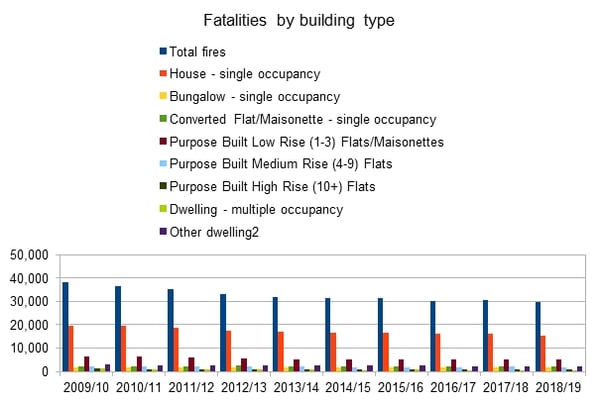Despite the new regulations that have been introduced or proposed following the Grenfell tragedy in 2017, this is not the time to be complacent about fire. The latest available statistics on fire in England showed that fires actually increased in the year to March 2019. In the 10 years to 2012/13 there had been a steady drop in fires every year, but since then the figure has been slowly creeping up again.

In this last year, 2018/19, the Fire and Rescue Service attended 182,825 fires. This was a nine per cent increase compared with the previous year, a seven per cent increase compared with five years ago but a 27 per cent decrease compared with ten years ago. A significant number of the 2018/19 fires were ‘secondary fires’, that is, fires that had spread from their original source. The frequency of these largely relates to the weather, and the hot dry summer of 2018 was doubtless in part responsible. But with global heating, we should expect more of these.
The 73,214 primary fires (40% of the 182,825 fires attended) represented a one per cent fall on the previous year. There was no change compared with five years ago (73,230) and a 30% decrease compared with years ago (104,348). In comparison with the previous year, there was a decrease of 4% in fires in dwellings and other buildings.
Grenfell has, rightly, focused attention on the safety of high-rise buildings but it is worth remembering that such fires, while they have the potential to be devastating, represent a relatively small proportion of all dwelling fires. In 2018/19 only 3% of fires in dwellings were in purpose-built high-rise. Of the 29,570 primary dwelling fires that the Fire and Rescue Service attended, around three-quarters (74%) were in houses, bungalows, converted flats and other properties, whilst around a quarter (26%) were in purpose-built flats. If we break down the figures for purpose-built flats, we find that 17% of all dwelling fires were in purpose-built low-rise (1-3 storeys) flats/maisonettes and 6% in purpose-built medium-rise (4-9 storeys) flats, leaving that figure of 3% in purpose-built high-rise (10+ storeys) flats.
In 2017/18, 52 (6%) of the 801 fires in purpose-built high-rise flats spread beyond the room of origin. This shows that fire is not being contained well.
The other really significant figure is how many people died in fires. Every death is a tragedy, so no figure can be considered ‘good’, but the lower it is the better. In 2018/19 there were 253 fire-related fatalities. This compares to 339 for the previous year, which included the 71 people who died in the Grenfell tragedy.

Fire-related fatalities have fallen by 9% compared with five years ago, when there were 278 fire-related fatalities, and by 22% compared with ten years ago, when there were 323 fire-related fatalities. Fire-related fatalities had been on a
downward trend since the 1980s but have plateaued in recent years. This year’s figure however is the lowest number of fire-related fatalities in the series of statistics.
So there is modest room for congratulation, but these figures are still not good enough. More recently, we have had the worrying student fire at Bolton and the fire in the Travelodge in Brentford. Neither has been fully analysed, but the first indications are that the cladding may have played a part in the first fire and probably did not in the second.
What these two fires, at which fortunately there were no fatalities, remind us of, is that we must be vigilant. We must work to prevent fire; we must not use materials that encourage it to spread; we must build in a way that prevents it spreading; we must protect means of escape; we must suppress fire wherever possible; we must get rid of smoke; and we must make it possible for the Fire and Rescue Service to do its job as quickly and effectively as possible. Put another way, we must design our buildings correctly, build them correctly, and maintain them correctly. We must be particularly vigilant about putting the correct measures in place to remove smoke, which can kill in two ways. It can kill directly, because it is toxic, and it can hamper rescue efforts and ease of escape.
We must, in particular, think about the protection of existing buildings. While Grenfell was the most tragic example of a building that became more dangerous throughout its life, most negligence is less dramatic. It includes, for example, breaching of compartmentation by ill-considered minor building works.
It is too easy to concentrate on the important issue of new construction and forget about the vast number of buildings that are already in existence and occupied. These buildings must be maintained correctly and that means that competent people must inspect and work on them to ensure that all elements of the fire protection are working properly.
Only when we get everything right, in terms of maintenance as well as initial design and construction, on every building, will we be able to minimise the danger of fire. Then we will save lives and cut damage to properties and disruption to everyday life. We are travelling, broadly, in the right direction, but we must do more.
